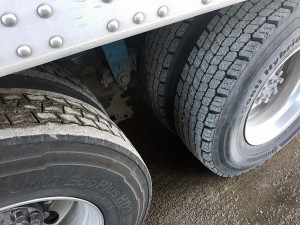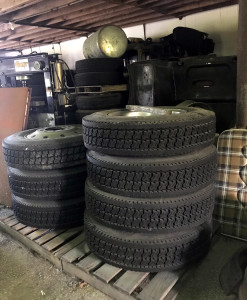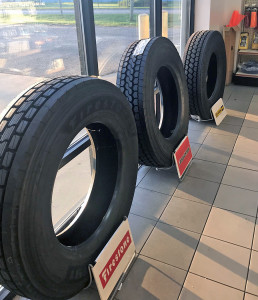 This week I was included in a Facebook conversation on the 10-4 page that started with where to find good tires for cheap. That’s a big subject to discuss in only a limited number of characters.
This week I was included in a Facebook conversation on the 10-4 page that started with where to find good tires for cheap. That’s a big subject to discuss in only a limited number of characters.
The first question was how much weight is too much when balancing a tire. Another person asked if it was necessary to balance a good tire? As one would expect, everyone chimed in, or at least it seemed that way. There were equally as many different suggestions on how to set up new tires as there were respondents. I’m not even sure there is a “correct” answer to this complicated and often expensive purchase. However, I will weigh in here, as well, but bear in mind, this is only my opinion and not absolute, definitive or by any and all means the only correct answer.
Price is only one factor in buying components for your truck and trailer. Price should only be a guideline, and not a deal breaker. So, what is a good price? That depends on what you are willing to consider as alternatives. Also, how much time do you have to shop your purchase. Tires are not something you normally run out and purchase just because they are on sale. However, if a smart operator is watchful, they can pick up some good deals if they are prepared to buy when the opportunity presents itself.
This is a trick many good owner operators and fleets have used to beat the tax man. What? You can legally beat Uncle Sam? Sure. You get the taxable expense in the year you spend the money, not in the year you use the product. Tires are one of those big expenditures that store well for later use. I prefer to buy most of my tires late in the calendar year. This puts me on new rubber for the snow season. I consult my accountant, as well, to see if I need the expense in this year or not. If I don’t need to spend any more money in the current year, then I try to push the purchase out until the first month of the next year.
I hear someone out there saying they can’t pre-purchase tires because they have no place to store them. Don’t panic. Depending on where you bought your tires, they often have plans to pick them up later or in a different place. That too can be factored into the tire price. That is a short stab at WHEN to buy. Now let’s discuss WHAT to buy.
First, you need to ask yourself how you are going to use the product and what your expectations are. For this article, we will be looking at tractor tires, both steer and drives. I have spent a considerable amount of dollars on these over the last 30 years. When I was first starting out as an owner operator, my funds were quite limited, for sure. I remember the first set I purchased was two tires at a time, then I replaced four tires per axle, until I had a complete set. Yes, it took me a while to replace them all, but by moving tires around and turning in the old cases for caps, I was able to get by. Do I recommend this practice? Sure. This is just another form of money management.
Tires are as diversified as the freight we move, and that begs the question: what do you do with your truck? This is a serious question, and one of the first questions you need to address when purchasing any part or consumable you use. List some essential aspects for your use, like where you run and how much weight you haul. Are most of your miles on-highway or do you go off-road? What speed do you run, and does ambient temperature affect your operation? Do you run in northern climates that require chains or traction devices? If so, what type do you use? This is all useful information that should be taken into consideration before you set a price point for new tires.
 We all know when our tires are worn out, but do we know why? Sure, I understand miles cause wear, and the more miles you cover the shorter the lifespan of said tires. But, what can you do to save your tires and, hence, save money? I’ve used multiple tire brands over the years, and some were more successful than others. It wasn’t until I started to understand why different types of tires were recommended for specific applications that I was able to actually extend their usable lifespan.
We all know when our tires are worn out, but do we know why? Sure, I understand miles cause wear, and the more miles you cover the shorter the lifespan of said tires. But, what can you do to save your tires and, hence, save money? I’ve used multiple tire brands over the years, and some were more successful than others. It wasn’t until I started to understand why different types of tires were recommended for specific applications that I was able to actually extend their usable lifespan.
When most of us think of tires we only think about the rubber we look at when we are doing that pre-trip. Do you remember why you are kicking them in the first place? That’s right, to check the air pressure. I don’t think those flip-flops are gonna cut it. You should probably use a hammer or cheater pipe for the best results. I still like to check them at least once a week with a tire gauge. I do, however, have a neat little trick to check them using a thermal scanner to see how close they are running to each other. Any tire with low air pressure will generally run at a higher temp than the others, and the chances of all your tires being low is slim to not. This method only works when the tires have been rolling and have some heat in them, so it is not a reliable pre-trip application. The old time-tested air gauge is still best for that.
I’m going to use myself as the test dummy this month since I’m in the market for some new skins myself. First, let’s establish some guidelines for how I intend to use them and what I expect them to do. I run 90% of my miles on the highway, and 75% of those miles are at or below 80,000 lbs. (about 25% of the time I go up to 170,000 lbs., which is the legal weight allowed in Michigan and to the Ohio ports). Even when under heavy loads, the state only allows for 34,000 lbs. on my drive axles, however I can run heavy on the steers.
But it’s not the weight that causes excessive wear – it’s the wheel slip that occurs when turning and changing gears, so we select a tire that has high scrub resistance and a harder tire compound to reduce wear. We tend to use 16 ply tires, commonly referred to as H rated. This is a type of tire used a lot in regional applications and commonly seen in steel mills and in ocean ports. These run at 120 psi, which helps the tire stand up better and cuts down on flex, which leads to increased tire temp and stress. If you do a large amount of LTL or steel mills, you might want to consider these since they have a greater resistance to damage. There is a common misconception that 16 ply tires are very expensive. When pricing any product, look to see how the cost compares per mile, not per piece.
I work a lot in the Deep South and Southwest, where the temperature of the road surface can exceed 140 degrees. This can be a cause for wear, as well. Wear caused by heat can be controlled by altering your driving habits. Speed kills even more than weight does – the faster you move, the more flex in your tires, the greater the temperature of the tire casing. As the temp increases it leads to checking and cracking of the case, which can develop into separation of the tread from the casing. This is relatively common in wide-based tires since they only have two sidewalls and the height of the sidewall is taller than a single tire used in dual applications.
 Most of the time, when you have a tire go bad, a tire shop will claim that it has been run flat or on low air pressure. When testing tires, we use a thermo scanner to check road temps and tire casing temps under different operating conditions. My rule of thumb is when the ambient temp is 95 or higher, I decrease my road speed until I get the tire temp back within the acceptable range (I’m looking for temps under 140 degrees). I’ve seen steer tires reach as high as 175 degrees when crossing California on I-15. If you want to test my theory, next time you notice the tread of your tires looking dusty or when you rub your hand over the tread and you get little dust balls, that’s tire tread rubber. Same holds true when drivers make radical maneuvers in the parking lot – all those black marks left behind are lost tire tread, too.
Most of the time, when you have a tire go bad, a tire shop will claim that it has been run flat or on low air pressure. When testing tires, we use a thermo scanner to check road temps and tire casing temps under different operating conditions. My rule of thumb is when the ambient temp is 95 or higher, I decrease my road speed until I get the tire temp back within the acceptable range (I’m looking for temps under 140 degrees). I’ve seen steer tires reach as high as 175 degrees when crossing California on I-15. If you want to test my theory, next time you notice the tread of your tires looking dusty or when you rub your hand over the tread and you get little dust balls, that’s tire tread rubber. Same holds true when drivers make radical maneuvers in the parking lot – all those black marks left behind are lost tire tread, too.
I do a considerable number of multiple stop deliveries, so I’m prone to scrubbing my sidewalls in city traffic and needing to back over raised sections of curb and abrasions. I am prepared to give up some price points to get the right tire for the job. Now, if my whole range of freight was limited to 60,000 lbs. and I only ran the middle of the U.S., then I might consider a lesser-quality tire. Remember, you will get what you pay for. I read somewhere, “The sweetness of the sale will be lost on the sour taste of poor quality.” I don’t know who said that, but I do know it still holds true.
I’m a northern driver, that is, my home is in Michigan, and on occasion I get to visit there. With that being said, traction is of utmost importance. But I still want good reliability and a long service life, too. I don’t care how you cut it, that’s a tall order. I run Florida most winters and deliver to the snowbirds who winter in the sunny South. In any given week, I can range from -20 degrees and hip deep snow to 90 degrees and sunny, then run into flood waters deep enough to push water with my front bumper. Can you buy a multi-purpose tire that does everything? I don’t think so – at least I haven’t found one yet. What I have done is determine what covers as many bases as possible.
Tires are the same as all the other parts that make up your truck. They are best utilized when the application is correct, and all the components are working together. There has been considerable discussion about how to properly balance tires and who is the best. I won’t get into that topic this time, but what I will say is that I like wheel balancers and alignment studs used on all axles. Take some time and research your options then, when you think you have a match, call your tire dealer and get their opinion.
When making a very high-dollar decision like buying 10 or even 18 tires, you want to have confidence in your purchase (their price point or your cost per tire may be more affordable then you think). Sometimes, you need more than the truck stop can offer. Your tire dealer should be your best employee, after all, aren’t they supposed to be working for you? Best of luck and may all your miles be smooth sailing on that sea of concrete. Till next we meet, don’t forget to kick the tires and light the fires. Time for me to get back truckin, 10-4!
